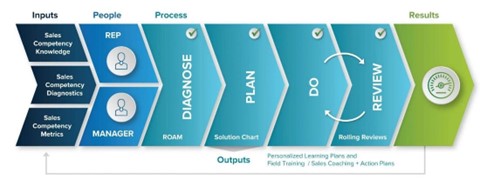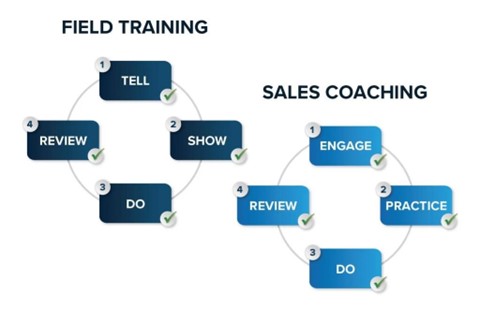How to Maximize Opportunistic and Developmental Coaching

In this post, I’ll focus on making the most of both opportunistic coaching (the one that occurs the most) and developmental coaching (the one that occurs the least). To lay a solid foundation, let’s review the four most common types of coaching:
- Strategic Coaching: Focus on strategy to create a plan to achieve predetermined objectives. Tends to be broader; focused on what to do. For example: How to determine the best possible approach to maximize growth in a territory.
- Tactical Coaching: Focus on the tactics to execute the strategy or achieve an outcome. It generally targets how to do something, but is usually more directive than focused on the skills needed. For example: How to navigate the buyer landscape most effectively, for a specific opportunity.
- Opportunistic Coaching: Focus on a response to something observed in the moment. May be strategic or tactical, but is most often tactical. Can be skills based (but in practice, often isn’t). For example: “I just saw you do [X] and experience [Y]. Why do you think that happened?” [Discussion] “May I offer some thoughts on how to get a better response?”
- Developmental Coaching: Focus on mindset, beliefs, knowledge, and especially skills, competencies, and behavior. Developmental coaching is targeted, planned, purposeful, behavioral/skills based, and outcome focused. It fosters getting into a cadence of coaching for continuous skill improvement to reach sales mastery. For example: “Where should you focus improvement efforts this quarter and what skills should you develop to full mastery, in order to improve your sales performance the most?”
Now, let’s take a deeper look at opportunistic and developmental coaching.
| Opportunistic Coaching | Developmental Coaching | |
| Focus |
|
|
| Inputs |
|
|
| People |
|
|
| Process |
|
|
| Outputs |
|
|
| Results |
|
|
Maximizing Developmental Coaching
With that foundation laid, let’s take a closer look at both developmental and opportunistic coaching, so we can maximize each. We’ll start with developmental coaching so we can refer to it when discussing opportunistic coaching.

The Sales Coaching Framework and the SLED model shown above represent how to make this actionable. Refer to the graphics as needed, as we walk through the framework and model.
The framework has Inputs, People, Process, Outputs, and Results. When done, it starts over at the beginning:
Inputs: This includes whatever reports, assessments, and metrics exist to diagnose rep performance and skill levels.
People: In this developmental journey, reps and managers work together, as a team. The rep owns their development, and their manager is their guide.
Process: The process includes steps to diagnose, plan, do, and review. Meetings occur throughout the process. We say you “SLED through these meetings” (meaning you follow the steps in the SLED model to run them). In the diagnosis and plan stages of the process, multiple meetings might be required (with the steps of SLED spread across meetings); or, if there’s time, they might get through SLED in one big meeting.
In addition to the inputs, the ROAM model supports the diagnosis stage, by comparing the results to the objectives to know where to focus to improve performance, and using the activities and methodologies in that area to conduct a root cause analysis.
Once you know the root cause problem you move to the plan stage to determine the best solution. It may be training, coaching, feedback, or something else (or The Solution Chart) that supports the plan stage and helps make this determination.
Outputs: This results in one or more outputs, such as a personalized learning plan, field training, or sales coaching. Then, you apply the most appropriate model(s), at the right points in your ongoing meetings, which you continue to SLED through.
The Field Training and Sales Coaching Models
| Field Training | Sales Coaching |
|
|

Field Training and Sales Coaching
Sometimes training is all that is needed. Sometimes you train one topic and coach another. At times, you train on a topic that requires ongoing coaching to get better until a rep reaches mastery.
After the field training and sales coaching sessions, when the rep is ready to apply their new skills and approaches with buyers and customers, they create an action plan to implement what they have learned.
Then the reps go to the “do” step (implement their plan) and get together again with their managers after some time to review progress toward skill mastery and improved results.
In some cases, it might require rolling reviews (an ongoing loop between “do” and “review”) to reach mastery of the skill(s) being trained and/or coached. Ongoing meetings occur, using SLED and the appropriate other models, until mastery is achieved and results in this targeted area improve.
Maximizing Opportunistic Coaching
If opportunistic coaching is a response to something observed in the moment, the question becomes how to maximize that opportunity you’ve been given.
Managers should ask themselves:
- How urgent or important is this opportunity?
- What’s the potential for performance improvement?
The Best of Both Worlds
This is how both opportunistic and developmental coaching can be used to support sales force development, sales effectiveness, and growth.
Developmental coaching gets your managers and reps in a cadence of continuous skill improvement, focused on skills that, when improved, will contribute significantly to improving results.
In contrast, opportunistic coaching helps managers take advantage of their in-the-moment interactions with their sales teams. Some of those may enter the developmental cycle, and others may be addressed on their own, using some of the same methods and tools.
Combined, you have the best possible chance to maximize both opportunistic and developmental coaching, and make the most of every coaching interaction, to improve sales skills and lift sales force performance.
For more information about developing sales managers into effective sales coaches, visit https://sparxiq.com/sales-coaching-excellence.
Mike Kunkle is a respected sales transformation architect and internationally recognized sales training and sales enablement expert. He’s spent 34 years in the sales profession and 24 years as a corporate leader or consultant, helping companies drive dramatic revenue growth through best-in-class learning strategies and his proven-effective sales transformation methodologies. Today, Mike is the Vice President of Sales Effectiveness Services for SPARXiQ, where he advises clients, writes, speaks, leads webinars, publishes sales training courses, and designs sales enablement systems that get results.
Get our Enewsletter
Get the latest sales leadership insight, strategies, and best practices delivered weekly to your inbox.
Sign up NOW →